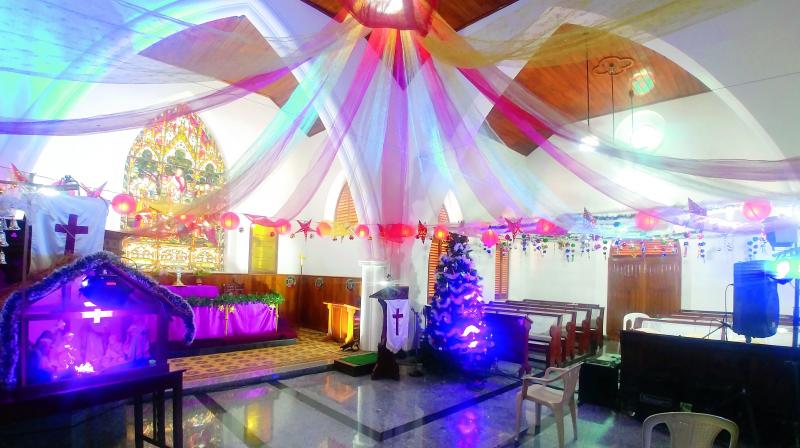Church sans bell

Among the British Indian Army, which was stationed in Secunderabad in 1798, there were a lot of Christians. Among them were the Wesleyan Methodists. So, it was Henry Little, William Burgess and evangelist Benjamin Wesley who helped establish churches in Hyderabad after winning over new converts.
It is believed that the cornerstone of the Garrison Wesley Church was laid in 1853.
The church is located in the crowded Lal Bazaar at Trimulgherry in the Cantonment area. The first look of the church gives a feeling of déja vu. It is like a picture postcard with a steeple rising and reaching out to the azure blue sky and the nativity scene adds to the colour. Though on a crowded lane, once you enter the church, it gives you a feeling of being ensconced in warmth and years of devotion.
There was a debate whether to reconstruct or renovate the church and it was renovated as the devoted people wanted to preserve history. The work for the church began in 1853 but was completed only in 1881. The present Wesley Girls’ School with its Missionary Bungalow was purchased in 1884.
Until 1878, the construction work was stalled and it was Rev. William Burgess, who came from Madras, who restarted it along with by Rev. Charles Walker Posnett who is also associated with the construction of the Medak church.
As per the citation of the INTACH Award, which the church received in 2015, it is one among the ensemble of buildings and cemeteries that served the British in Secunderabad following the alliance with the Nizams. There are Commonwealth War graves, tombstones and memorials.
This church is a fine specimen of what is known as the ‘Carpenter Gothic Architecture,’ the style used for smaller churches. These churches have unembellished surfaces and lack ornamentation. Garrison Wesley Church has pointed arches, flying buttresses and steep gables, lending the building grace.
The parsonage is within the campus and has a worldly dusty look about it.
The church did not possess a bell of its own. So, it had to be shipped from England. A ship was sailing from London, carrying Lillian Burgess and Arthur Burgess, wife and son of Rev. William Burgess. The new church bell was also with them when the ship sank midway, killing many and the bell got lost in the sea. Even today, the belfry does not have a bell.
This church was built with lime and mortar as was the practice then. The church was in a pretty bad shape, having weathered time and age, with the old rafters threatening to give way. The restoration works were given to a firm, APTSORBH, from Kanyakumari district in Tamil Nadu. Considering its antiquity, age-old techniques and materials consisting of eggs, jaggery, herbs, aloe vera, fine lime powder and lime mortar were used for its construction.
The re-dedication ceremony took place on December, 21, 2014. The entire cost was borne by the devotees with a little outside help. Credit apparently goes to the then pastor Rev. S.P. Vidyasagar.
The rededication mass was witnessed by the entire congregation with a procession taken out in the Lal Bazaar area in the presence of then vice-chairman Rev. A.C. Solomon Raj, who is the Medak bishop now. This church comes under the aegis of the Protestant Church of South India (CSI) within the jurisdiction of the Medak diocese.
Present pastor D. Prasanna Kumar is keen on history. He restored all the pews in house for the Christmas. His wife, Mrs Jacqueline Prasanna, is also a pastor in the same church.
Situated on seven acres, the campus is studded with trees. And then there is Ramgopal Hall, which is now a boys’ hostel and can accommodate 25 students, donated by philanthropist Ramgopal Malini. The major recognition came in the form of the INTACH (Indian National Trust for Art and Cultural Heritage) Award in 2015, wherein the citation appreciates the efforts to renovate the church.

